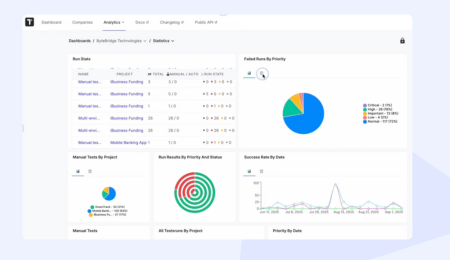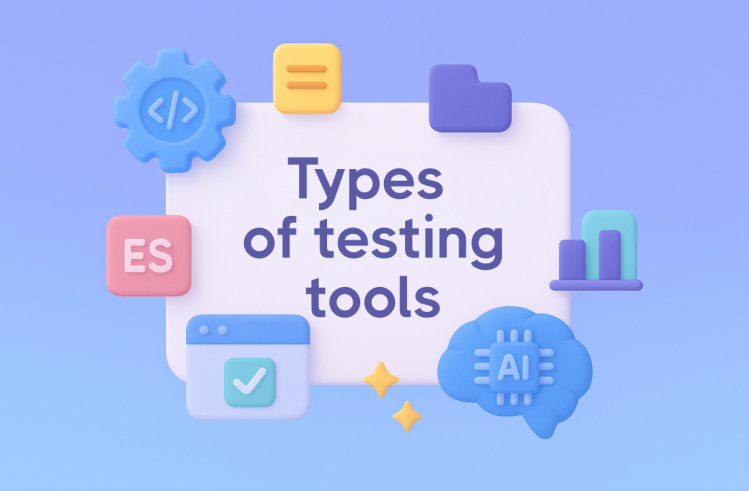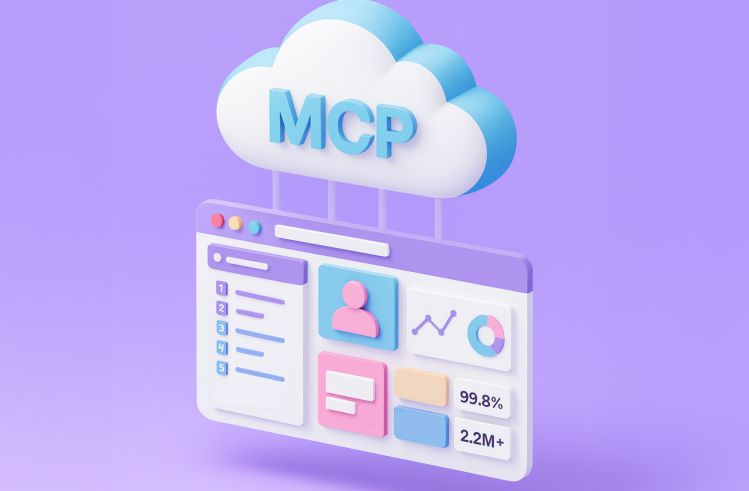When a development team introduces any new changes to a digital solution, it is impossible to predict how the system will behave afterward. To minimize the likelihood of failures, it is essential to perform regression tests at this stage. Let’s define this concept ⬇️
What is Regression Testing?
Regression testing is a type of software testing used by testers to check the correctness of the entire system’s operation after changes have been made to system components.
Especially regression testing plays a particularly important role in projects where a version control system is not implemented. In such projects, it is impossible to track which frequent changes caused a failure. Therefore, it is recommended to run regression tests regularly, as this will ensure that changes do not cause errors in core functionalities or performance issues.
Regression Testing Types
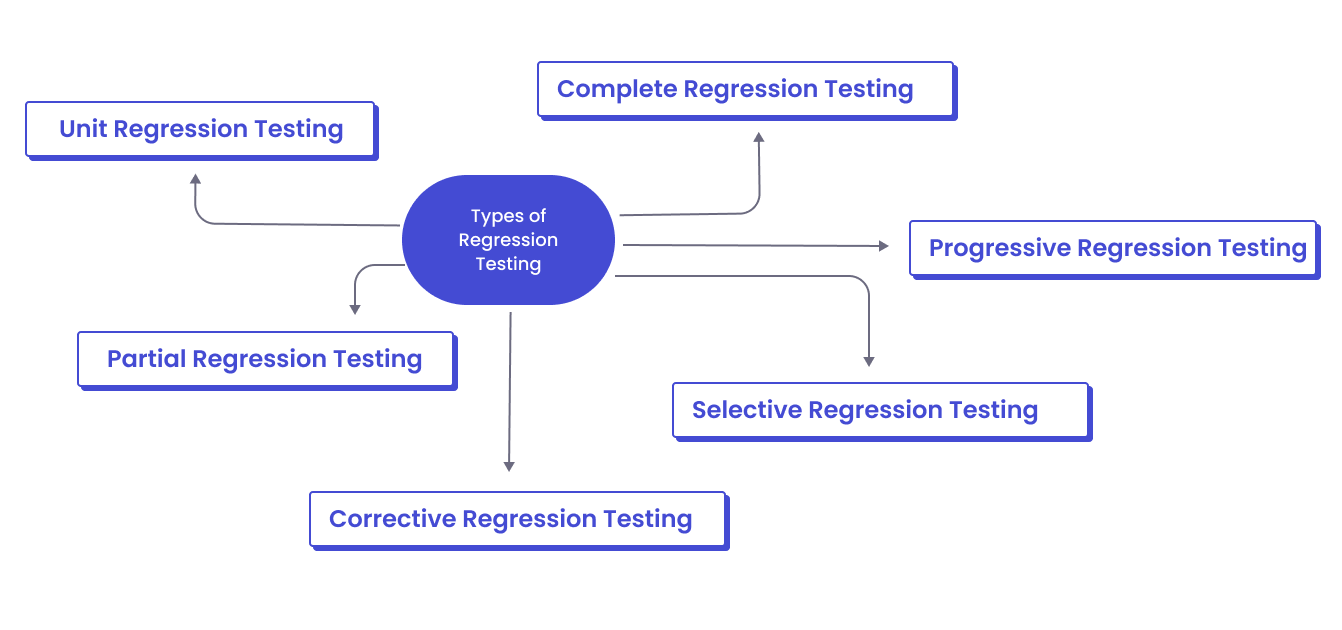
Seven types of software regression testing are distinguished within the regression testing strategy. Their goal is the same—to identify failures or errors in the current system after certain changes have been made to it. The difference is that each testing type uses a different regression testing approach. Let’s take a closer look at them.
#1: Unit Regression Testing
These tests aim to check individual existing modules of the code, ensuring their suitability for use. QA teams may consider code lines, functions, methods, classes, and so on as modules.
Unit regression testing is conducted during the coding stage of the digital solution and requires considerable time to write test cases. However, ultimately, it helps reduce the software development cycle and save the project budget.
#2: Partial Regression Testing
This type of regression testing allows testing teams to identify problems arising while integrating new code and previously written codebase. It helps ensure that the existing product functionality remains unchanged as a result of changes made to one of the code modules.
Partial regression tests should be run even after minor code changes; however, these testing efforts are necessary to ensure that the introduced fixes do not negatively impact existing functionality.
#3: Complete Regression Testing
In contrast to the previous type, complete regression testing retests the entire application. It requires more resources, so it is advisable to conduct it only when several changes have been made to the source code at once.
This type of testing involves writing extensive test suites; however, the advantage of complete regression tests lies in reusable test cases. Additionally, they allow conclusions to be drawn about whether the system is ready for release.
#4: Progressive Regression Testing
This regression testing approach involves gradually adding new test cases to the existing test suite to check new functionality or any code changes.
These tests allow the QA team to determine whether the introduced changes affect existing functionality.
#5: Corrective Regression Testing
Corrective regression testing is conducted after changes have been made to the software application to address previously identified defects. In other words, it ensures that fixing previous errors does not lead to the emergence of new ones.
Although sometimes conducting tests of this type can be a tedious and time-consuming task, it is simplified by the ability to apply reusable test cases.
#6: Selective Regression Testing
This testing approach involves selecting from the entire array of existing test cases those that are necessary to check modified code. Selective testing occurs after new code blocks are added to the codebase.
These tests are useful when you need to check individual system components. You can save time and resources by foregoing complete regression tests in such situations.
Regression Testing vs. ReTesting
Although both regression testing and ReTesting involve rerunning tests, it is important not to equate these concepts. The difference between them is that regression testing is aimed at checking the impact of source code changes on the existing functionality of software applications. At the same time, ReTesting is performed when it is necessary to verify how effectively a detected error has been rectified.
To illustrate, we offer a comparative description of these types of testing:
| Regression Testing | ReTesting |
| Checks that new changes have not caused new defects | Confirms the elimination of an error and the restoration of system core functionality |
| Conducted after changes are made to the application’s source code | Executed after an error is detected and rectified |
| Can be conducted concurrently with ReTesting | Should be conducted prior to regression testing |
| Uses passed test cases | Uses failed test cases |
| Subject to automation |
Cannot be automated |
Regression Testing Techniques
In their practice, QA teams use various regression testing techniques: retest everything, regression test selection, test case prioritization, and hybrid testing strategy. Let’s take a closer look at them.
Retest Everything
This method is used when regression testing needs to be applied to all test cases. It provides a comprehensive check of the system for errors, but it requires a significant amount of time and resources. Therefore, performing regression testing using this technique is recommended after major fixes in operating systems or multiple code changes.
Regression Test Selection
This technique is not as time-consuming as the previous one since it allows the selection of specific components for which you should run regression testing. At the same time, adjacent areas are only indirectly affected – a limited number of regression test cases are applied to them.
Test Case Prioritization
This method involves identifying test cases that should be given priority attention. The selection may be based on several criteria, such as the importance of a specific function to the business, the frequency of its use, or the number of failures encountered.
Hybrid Testing Strategy
This regression testing approach combines the principles of regression test selection and test case prioritization. The strategy eliminates the need for the testing team to execute all test cases. Instead, they can run regression tests only for the changed parts of the code, prioritizing those that are critical to the project.
When should Regression Testing be Done?
Regression testing should be conducted every time any changes are made to the source code. This can occur in the following cases:
- Changes in project requirements. Any changes in requirements for the software applications being developed entail code changes. After these changes are made, it is necessary to verify whether they have altered previously working functionality.
- Adding new features. In this case, it is also necessary to ensure that the new functionality has not negatively impacted existing features.
- Fixing defects. Regression tests are not intended to verify the fact of error correction. They will show whether the changes to address the issue have caused new bugs.
- Addressing performance issues. After resolving any system performance issues, it is important to confirm that the new version of the application does not encounter problems with overall performance.
If any of the situations mentioned above arise in your project, it is time to understand how to incorporate this testing type into your workflow.
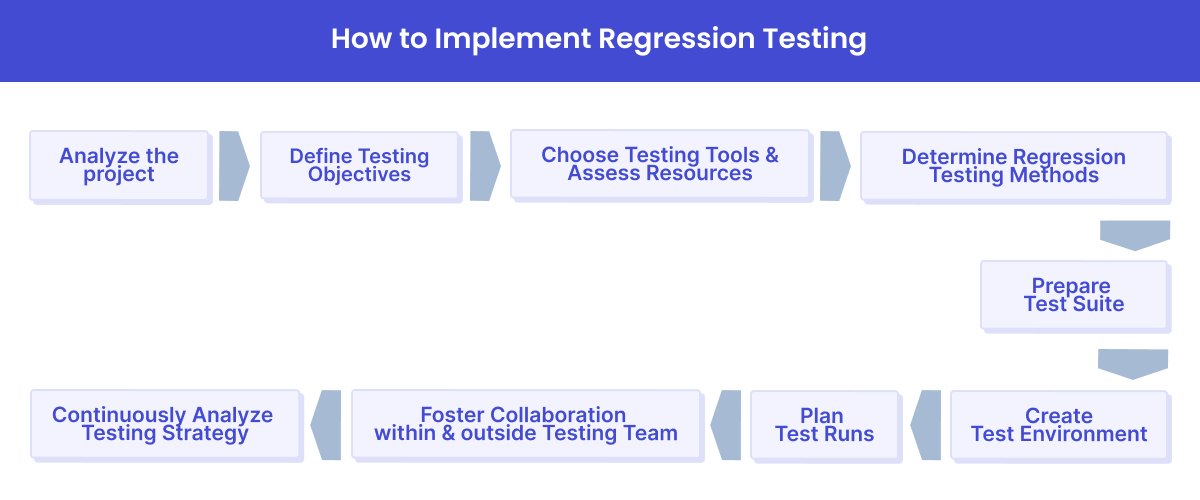
To successfully implement regression testing into your development cycle, careful preparation is necessary:
Step #1: Analyze the Project
First, determine the scope of the upcoming testing. Verify core features and areas of increased risk. Ensure that you understand the project goals and user expectations.
Step #2: Define Testing Objectives
This stage involves a clear understanding of why regression testing will be conducted, for example, to assess the impact of code changes on the system or to check the stability of the software application. Then, determine which elements will be tested: integrations, features, etc.
Step #3: Choose Testing Tools and Assess Resources
Check the adequacy of the QA team’s skills for running regression tests and the availability of necessary resources. Choose an appropriate testing tool aligned with the project goals.
Step #4: Determine Regression Testing Methods
As mentioned earlier, this type of testing is well-suited for automation, so consider which of your regression tests you can automate and when manual testing is more appropriate. Also, you should set up continuous integration for ongoing checks.
Step #5: Prepare the Test Suite
Create a new or update an existing test suite according to the testing objectives. Ensure modularity and reusability.
Step #6: Create the Test Environment
A stable testing environment allows for efficient test data management and ensures a consistent and coherent workflow for the project.
Step #7: Plan Test Runs
At this stage, determine the frequency of test execution, for example, after completing a sprint or before a new release. Consider which reporting tools you will use to track testing results.
Step #8: Foster Collaboration Within and Outside the Testing Team
Ensure quality interaction between testers, developers, and other stakeholders for an effective regression testing process. Everyone should be informed about the progress of conducting regression testing, as well as any defects discovered and the plan for addressing them.
Step #9: Continuously Analyze Testing Strategy
Flexible development methodology implies constant changes in project requirements. Therefore, it is necessary to monitor the alignment of the testing strategy with these changes and continually improve it based on feedback and results.
Features of Conducting Regression Testing
To conduct high-quality regression testing, QA professionals typically take the following steps:
- Selecting test cases for repeated testing. Before starting testing, it is necessary to determine which tests need to be repeated. It is recommended to include checking areas of the application in the test plan where errors have occurred most frequently—they are likely to be the most susceptible to failures due to source code changes. It is also essential to test the core features of the software product.
- Estimating the time for executing regression test cases. When planning the regression testing process, consider that your QA team will need time not only for test runs. Specialists also need to create test data, familiarize themselves with the testing tool being used, and work with reports.
- Test automation. Automated regression tests are more reliable and faster than testing performed manually. Testers tend to automate most regression tests, but in some cases, manual testing is needed. For example, graphical user interface testing and complex event sequences are often tested manually.
- Test cases prioritization. This step involves determining the most critical test cases that should be executed first. For example, test cases for checking the core functionality of the current system may be considered as such.
- Utilization of regression testing tools. Such tools enable teams to efficiently manage testing planning, execution, and reporting. In the next section of this material, we will discuss the role of test management systems in regression testing.
As you can see, a modern TMS with progressive functionality, such as testomat.io can expedite the regression testing process and streamline interaction among its participants.
Once the testing process is streamlined, testers have one crucial task left—correctly evaluating the obtained results. We will delve into this further next.
Evaluation Result of Regression Testing
Regression testing is a crucial and simultaneously complex stage of working on a digital solution. Especially when more and more new functionality is added to the system under test. Therefore, it is very important for QA teams to track certain metrics that will help accurately assess testing results. These metrics include:
- Test execution time. This is the time required to execute all test cases in an iteration. This metric helps determine how quickly regression testing progresses and also helps identify performance issues and weaknesses in the system or test environment.
- Test pass percentage. This metric shows the number of passed tests. It allows you to assess how stable and resilient the system is to changes. You can also determine the effectiveness of your testing strategy—how effectively your tests detect defects.
- Test coverage. This metric helps determine how thoroughly tests cover the functionalities of the software product. Analyzing test coverage allows the team to mitigate risks associated with insufficient testing of critical features.
- Defect density. Using this data, you can compare the number of defects to the overall size of the tested system. The resulting figures indicate the level of stability and reliability of the software product.
- Defect resolution time. This is the average time required to fix errors discovered during regression testing. To expedite this process, it is important to improve communication within and beyond the team, use TOP regression testing tools, and optimize testing strategy.
- Automation level. This is the number of automated regression tests. Improving this metric makes testing faster and more reliable, as well as saving time and resources.
Monitor these metrics to ensure that regression testing is effective and helps your team achieve its goals.
Why Is Regression Testing Important in Agile and CI/CD?
Modern agile software development methodologies involve constantly adding new code to the codebase. Regression testing ensures that continuous integration of code does not cause issues with existing functions. Thanks to automation, this type of testing is performed after minimal source code changes and verifies all critical business functions of the digital solution.
To make regression testing as effective as possible, use a modern TMS – testomat.io Contact our manager for a detailed consultation and improve your regression testing process today.
